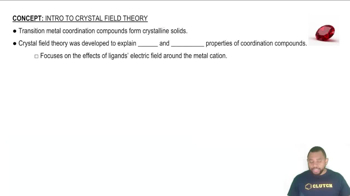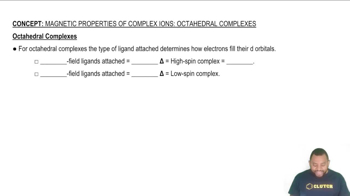Here are the essential concepts you must grasp in order to answer the question correctly.
Crystal Field Theory
Crystal Field Theory (CFT) explains how the arrangement of ligands around a central metal ion affects the energy levels of its d orbitals. In an octahedral complex like [Mn(NH₃)₆]²⁺, the d orbitals split into two energy levels: the lower-energy t₂g and the higher-energy e_g orbitals. The extent of this splitting is influenced by the nature of the ligands and the metal ion's oxidation state.
Recommended video:
The study of ligand-metal interactions helped to form Ligand Field Theory which combines CFT with MO Theory.
High-Spin vs. Low-Spin Complexes
High-spin and low-spin complexes refer to the arrangement of electrons in the d orbitals based on the strength of the ligand field. High-spin complexes have more unpaired electrons due to weaker field ligands that do not cause significant splitting, while low-spin complexes have fewer unpaired electrons as stronger field ligands lead to greater splitting, allowing electrons to pair up in lower energy orbitals.
Recommended video:
For octahedral complexes, Weak-Field Ligands create High-spin complexes and Strong-Field Ligands create Low-spin complexes.
Electron Configuration of Transition Metals
The electron configuration of transition metals is crucial for determining their magnetic properties and oxidation states. For manganese in [Mn(NH₃)₆]²⁺, the electron configuration is [Ar] 3d⁵ 4s², and upon losing two electrons to form the ion, it becomes [Ar] 3d⁵. The presence of five unpaired electrons indicates that this complex is high-spin, as the electrons occupy higher energy orbitals before pairing.
Recommended video:
Electron Configurations Of Transition Metals Example

 Verified step by step guidance
Verified step by step guidance

